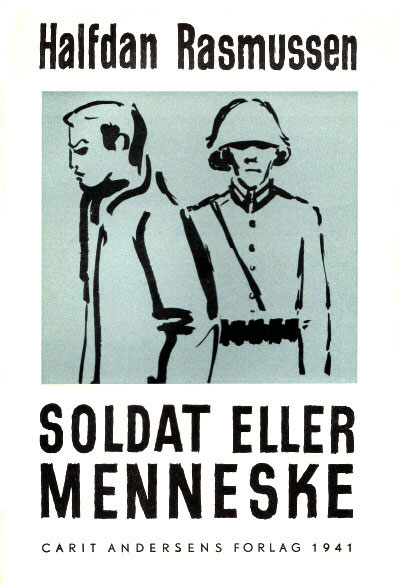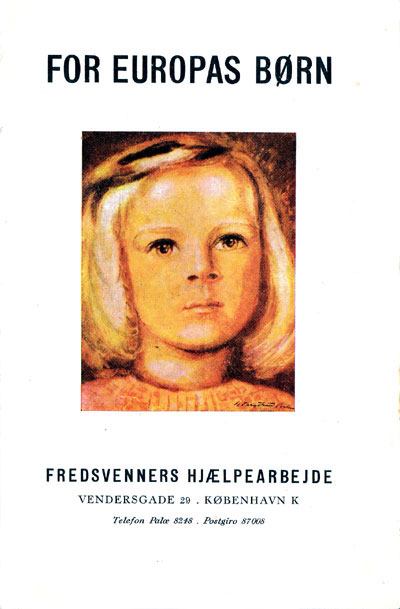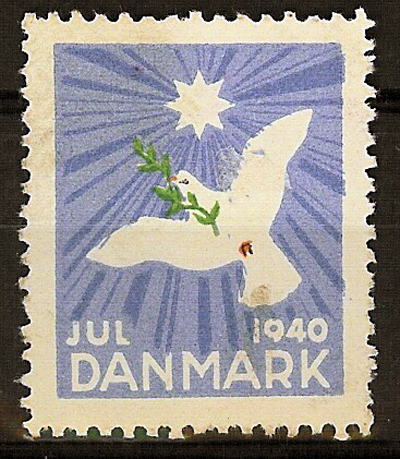The Danish Peace Academy
Holger Terp: Danish Peace History
Working paper 1
Non-violent resistance during WW2
 |
 |
 |
 |
 |
 |
The civil Danish aid and solidarity work in support of German, Jewish and Spanish victims of fascism as documented earlier, came to a stand by situation with the German military occupation of Denmark in the morning of April 9th, 1940. The official Danish policy at the beginning of the occupation was cooperation with the powerfull and by some Danes admired victorious Fascist Germans.
In March 1941 the Justice Department ordered the dissolution of Danish émigré organisations. The émigrés were placed in the Danish concentration camp Horserød. Thereafter the Danish Government deported the German political refugees and deserters back to Germany132; who according to the German military,
“werden wegen Vorbereitung zum Hochverrat von Deutschen Gerichten gesucht. Es besteht hier ausserdem der Verdacht, dass sie heute noch ihre staatsfeindliche Betätigung fortsetzen. Sie bilden eine Gefahr für die Aufrechterhaltung der öffentlichen Sicherheit und Ordnung und müssen daher für die Dauer der Anwesenheit der deutschen Truppen in Dänemark in Verwahrung genommen werden“133.
The German demand was „met“ so complete, that even the seized archives of the Danish émigré organisations were handed over to the Germans, who alas, “did not return them”134. Also 61 British and French citizens were deported to Germany on May, 17th. 1940135. The German language teacher Dr. Arnold Kalisch and his famely were overlooked. They escaped together with the Danish Jews to Sweden in 1943. Co-operation from the Danish police with the German police began even before the war in the International Criminal Police Commission136.
Export of Danish produced weapons and food to Germany and her allies took place during the whole war. Also some Danish companies worked inside Germany and in Poland for the Nazi military using Russian and Polish concentration camps prisoners. Younger Danish historians experienced during their research in this matter that those companies had destroyed their files from the years of the occupation137.
One of the first Danish resistance actions were the modern play of Aristophanes: Lysistrata renamed Dyveke, played at the Royal Theatre in Copenhagen from May 1940. The play of Aristophanes Lysistrata was first translated and published in Danish in 1969.
On October 12, 1935, the fascist Germany had forbidden Negro Music, Unerwünschte Musik: jazz. Therefore jazz became a popular form of protest during the occupation, which later became known as the golden age of Danish jazz.
Even American folk songs was released in Denmark during the occupation on gramophone records: Uncle Tom's Songs Part 1 and 2 with song by Victor Cornelius and Kauni and Lulo. Polyphon XS 51041.
The contents of the record is: Song of the islands; Carry me back to old Virginny; Old folks at home; Old Black Joe and Home sweet home. Polyphon XS 51043 is registered in the Swedish media archive as appeared in 1943. Song of the islands probably originating in an American film of the same name from 1942. I suppose that Kauni and Lulo were guitarists. It may be one of the first Danish EPs.
On the morning of August 29, 1943 the Germans banned the Danish State Radio from playing American and British music and the following day even Swedish music was banned: "No more Pan-Scandinavianism in the Danish Radio, no zoot suiting, no Jews, and no parlour bolshevism", Documents Frit Danmarks Hvidbog Vol 2, p. 1407.
At the end of 1940 the yearly published Christmas stamp appeared. The only Danish Christmas stamp with a peace dove as illustration. This might be the only peace dove published on stamps during the Second World War.
One of the major accomplishments of the Danish resistance movement was the illegal press; even the German émigrés had their own news agency and communicated their documents to members of the German army for instance Offiziere, Soldaten und Matrosen/ Deutsche in Dänemark/ Macht Schluss [illustrated Danish and German text at the Royal Library, Copenhagen]. Die deutsche Freiheitsbewegung zur Zeit der Besetzung Dänemarks documents, including Deutsche Nachrichten, were collected shortly after the war. The paper war of the illegal press and its news agencies such as Information was not only important sources of news and documentation for Danes and the rest of the world, but they also served as instruments for recruiting personnel to the militant resistance movement.
Thus the resistance work was partly non violent civil disobedience during war and partly violent, or as the Danish historians debate active and passive resistance. This is clearly exemplified by the medical profession.
In the meantime, the Danish coalition government submitted its resignation to the King and ceased to work on August 29, 1943. The Department Chiefs Regime / Departementschefstyret continued the Danish state's functions until the Liberation.
The resignation application from the coalition government was never acted upon by the King. Under normal circumstances - and according to the the Constitution - the Danish king should automatically accept a government's resignation, and call general elections. The Constitution Art. 15 states that the government must either resign or call an election if a majority in parliament says it lacks confidence in the Prime Minister. During the 1920 Easter crisis, King Christian X dismissed the Zahle government. Subsequently, the King promised to respect parliamentarianism as customary law and not to be active in policy. In Denmark since 1901 this has been formulated as negative parliamentarianism, meaning that a government shall resign when there is a majority in parliament against it. The government's resignation application of 1943 was never debated in parliament and elections were not called for in August-September 1943. The general election on March 23, 1943 was the only election during the occupation.
On October 3, 1943, the bishops protest on behalf of the
Evangelical Lutheran Church / Folkekirken, against the persecutions
of the Jews in Denmark was read as a pastoral letter at the
service. The escape to Sweden of the 5.600 Danish Jews, half Jews
and relativs to Jews around and after October 1943 was only
possible because the medical profession and students on a mass
scale helped the Jews to escape138.
The doctors used hospitals to hide the Jews and their cars for transportation139. Also the Danish chapters of WRI and the Women’s International League for Peace and Freedom were active in the rescue of the Jews.
Between 60 and 200 small Jewish children up to the age of seven were seperated from their parents and hidden in Danish families. This case is currently under investigation by historians at the Danish Jewish Museum.
However, not all the Jews were saved. Four hundred eighty-one Danish Jews ended in the concentration camp Theresienstadt.
After the escape of the Jews many of the doctors and students became active in the militant resistance movement.
In 1963 the Danish-American entertainer Victor Borge and the New York attorney Richard Netter founded Thanks to Scandinavia to commemorate the courage and decency of people who rescued Jews during WW 2140.
Members of the Other Germany, like Hilltgunt Zassenhaus (born 1916), tried to help Danish and Norwegian prisoners in Germany during World War II141. Her American autobiography was published in Danish in 1974.
The émigré professor Walther A. Berendsohn, the son of a Jew, escaped to Sweden in a small boat together with two German deserters from Luxemburg and a Danish saboteur142 and on October 22, 1942 the German soldier Alfred Andersch deserted in Germany and sailed to Denmark143.
Denmark was in the unique situation that it was the only German occupied country, where organised peace work could continue without German persecution and imprisonment of pacifists. Thus Denmark became a safe heaven for German peace literature during World War Two, because of close contacts between Danish and German pacifists.
A rare copy of Emil Flusser’s “Krieg als Krankheit” from 1932 survived the book burnings, May 10th. 1933 and November 1938 of the German fascists in Denmark144. Among other surviving books were Ernst Friedrich‘s: “Krieg dem Kriege” from 1925 (later reprinted in Germany) and Mathilde Vaerting‘s “Die Struktur des friedlichen Menschen” from 1933. Around 100,000 Jewish books at the Royal Library were hidden from the Germans145.
The Danish peace groups continued to publish their magazines and other publications during the occupation. In 1941 the young poet Halfdan Rasmussen (1915-2002) published his first pacific poems in “Soldat eller Menneske” / Soldier or Human.
The important Danish aid work during and after World War Two began with the aid to Norway founded in 1940 at Copenhagen by the Norwegian Ladies Committee146. During the war the aid work grew in size and importance. The peace groups organised nation-wide collections of money and clothes and training camps for volunteer skilled workers.
Even new peace groups like The Youths Peace Society147 and as the most important aid and relief organisation the Peace Friends Relief Work148 were established - the latter in January 1944. The Peace Friends Relief Work was supported by all the Danish peace groups, the Quakers and Kirkeligt Verdensforbund.
Also on March 14, 1945 the Danish chapter of International Save the Children Alliance, Red Barnet, were established by Danish women organizations.
At the end of World War II hundreds of volunteers Danish craftsmen organised by the Peace Friends Relief Work supported by the governments Liaison Committee Concerning International Aid Work established in September 1944; the Danish Red Cross and Save the Children149 were ready to begin aid- and reconstruction work in Belgium, France, the Netherlands, Norway, Finland and Poland. Food parcels relief were also sent to Austria, Hungary, Czechoslovakia, Germany and the Soviet Union.
The motives for participating in the aid and reconstruction work was for the pacifist reconciliation and for the government bridge building into the victorious allied countries which succeeded when Denmark in late 1945 joined the United Nations150. When the Danish government in 1946-1947 closed the food aid programmes because of a poor balance of trade, the successful global International Tuberculosis Campaign was created in 1948.151. The International Tuberculosis Campaign lead to the making of UNICEF a pernament UN-organization in 1953. UNICEF was created on the basic of the UN aid- and reconstruction UNRRA, established after World War Two.
In November 1946 the Danish chater of the World Association of World Federalists was created.
Danish United Nations societies organised the umbrella organisation Dansk Samråd for forenede Nationer.
In 1948 the United Nations Day replaced the League of Nations Day on October 25! First year only, as October 24, 1948 was a Sunday.
In 1947 Peter Manniche was a Danish delegate to the UNESCO conference in Mexico City. Manniche “aimed at education for international understanding” with “adult education as a way to peace”152. According to the Australian education historian Max Lawson, Manniche was “instrumental in arranging the first UNESCO international course on adult education” in 1949. It marked the beginning “of an international adult education movement”153.
In the meantime the military American bases on the Danish colony of Greenland changed the security policy of Denmark as she became a member of NATO in 1949 and the most important Thule Air base was created during the cold war.
Notes
132 VII Anholdelse, Internering, Udvisning
eller Udlevering af fremmede Statsborgere / Arrest, detention,
expulsion or extradition of foreign nationals. In: Ministry of
Justice and Enforcement under the occupation, records. In:
Justitsministeriet og Retshåndhævelsen under
besættelsen, Aktstykker 1, 1950 p. 186-199. See also in
Danish: Udsendt til Tyskland : dansk flygtningepolitik under
besættelsen / Hans Kirchhoff & Lone Rünitz.
- Odense : Syddansk Universitetsforlag, 2007. - 522 s. - ISBN-13:
978-87-7838-989-3, and
Medaljens bagside : jødiske flygtningeskæbner i
Danmark 1933-1945 / The Back of the Medal : Jewish refugees fates
in Denmark 1933-1945. / Vilhjálmur Örn
Vilhjálmsson.
- Copenhagen : Vandkunsten, 2005. - 471 pp.
133 Ibid. p. 187.
134 Ibid. p. 189.
135 Ibid. p. 33.
136 Philipsen, Bernd: Tinte floß übers
Hakenkreuz : Dr. Arnold Kalisch - ein verfolgter Pazifist und
Jude.
AKENS Informationen 33/34, 1998.
http://www.akens.org/akens/texte/info/33/333408.html
Den Internationale Kriminalpolitikommission. Koch, Henning:
Demokrati slå til! Statslig nødret, ordenspoliti og
frihedsrettigheder 1932-1945. 1994, p. 232.
See also: Madsen, Carl: Flygtning 33 : Strejflys over Hitlers
Danmark, 1974 pp. 78-80.
137 Lov nr. 246 om Handel med samt
Tilvirkning og Besiddelse af Vaaben m.m. af 10. maj 1940. In:
Besættelsestidens Fakta, 1945. Vol. 1 pp. 9-11. The Danish
Arms producing companies and arms export during World War two are
documented in the Danish Peace Academy:
Dansk
våbeneksport til Tyskland under besættelsen.
De fem fede år. / Christian Jensen ; Karl Erik Nielsen. In: Berlingske Tidende, 04/17/2005.
138 Stræde, Therkel: October 1943 :
The Rescue of the Danish Jews from Annihilation, 1993.
See also the introduction to: Steffensen, Steffen: På flugt fra nazismen : Tysksprogede
emigranter i Danmark efter 1933  . 1987.
. 1987.
Translated into German:
Exil in Dänemark. Deutschsprachige Wissenschaftler,
Künstler und Schriftsteller im dänischen Exil nach 1933.
Hrsg. v. Willy Dähnhardt u. Birgit S. Nielsen. (Deutsche
Redaktion: Dieter Lohmeier), Heide 1993 Deutsche Ausgabe auf der
Grundlage von Steffen Steffensen: På flugt fra nazismen.
139 Den hvide Brigade : Danske Lægers Modstand / editor Aage Svendstorp, 1946.
October 43. / Aage Bertelsen.
- New York: G.P. Putnam' s Sons, 1954. - 246 pp.
- http://archive.org/details/october43aageber001971mbp
Flugten Til Sverige : Aktionen mod de danske jøder oktober
1943 / Rasmus Kreth ; Michael Mogensen. Gyldendal, 1995. - 178
pp.
- ISBN 87-00-20406-4
http://www.dchf.dk/pdf_filer/flugt%20DOC.pdf
Hong, Nathaniel: Sparks of Resistance : The Illegal Press in
German Occupied Denmark April 1940 - August 1943. Odense University
Press, 1996. - XI + 308 pp.
Hong has been investigating, for the first time, Statsadvokaturen
for særlige Anliggender's, indexing of the illegal press. One
of Hong's findings were that the Danish Communists had nearly
monopoly on the illegal press from October 1941 with the exeption
of Frit Danmark. Another of his findings were that by February
1943, the illegal press geographically covered the whole of
Denmark, still with the illegal Communistic press as the
dominating.
Hong is an American historian and media researcher; publisher
during the Vietnam war.
140 http.//www.thankstoscandinavia.org. See
also: A Brief Bibliography of Denmark and Greenland (1945).
New York, N.Y.: Danish information service of Friends of
Denmark, inc. 1945.
http://www.archive.org/details/ABriefBibliographyOfDenmarkAndGreenland
141 Zassenhaus Hiltgunt: Walls.
142 Steffensen, Steffen: Professor Walther A. Berendsohn. In: På flugt fra nazismen : Tysksprogede emigranter i Danmark, 1987, p. 257.
143 Haase, Norbert: Deutsche Deserteure. -
Berlin : Rotbuch Verlag, 1978. pp. 29-32.
Petersson, Lars G.: Deserters.
Danish Resistacne Museum Publishing, 2005. - 148 pp. - ISBN
87-88214-70-2
144 Dungen, Peter van den: Dr. Emil Flusser : Forgotten Precursor of the Medical Peace Movement. In: Medicine, Conflict and Survival, 1996:2 pp. 90-106.
145 Haxen, Ulf.: Det lille mirakel. Gyldendal 2003.
146 Boken om danskehjelpen. Oslo, 1947.The Norwegian aid collecting in Denmark closed down at the end of 1945.
147 Ungdommens Fredsforbund. File in the private files of Holger Terp. Ungdommens Fredsforbund is described in the thesis of Peter Kragh Hansen and Sune Petersen.
148 Fredsvennernes Hjælpearbejde. See: Haugaard, Svend: Fredsvennernes Hjælpearbejde. – Silkeborg : Aldrig mere Krig, 1947 and Kjeld Juul: Mod nye grænser : Fra europæisk genopbygning til u-landssamarbejde 1943-1963. Mellemfolkeligt Samvirke, 2002.
149 Red Barnet. Now part of the International Save the Children Alliance. The organisation works with children in armed conflicts and displacement.
150 Beretning til Rigsdagen: De Forenede Nationers første Plenarforsamling Afholdt i London 10. Januar –14. Februar 1946. – 115+131 pp.
151 Krogh, Tyge: Humanitært hjælpearbejde og udenrigspolitik : Om den statslige styring af det internationale hjælpearbejde 1945-1948. In: Spor – arkiver og historie. Afhandlinger tilegnet Niels Petersen, 1987. pp. 183-201.
Krogh, Tyge: Mellem efterkrigshjælp og u-landsbistand : Den internationale tuberkulosekampagne 1947-1951. 1989.
152 Manniche, Peter: Adult Education as a Way to Peace. In: The International Peoples College 1921-1971, pp. 18-75.
153 Lawson p. 74. See also: Gunnarsen, Evald: Die Entwicklung der Skandinavischen Volkshochschulen. In: Zehn Jahre Freundschaftheim Bückesburg, 1958. pp. 43-50.
|
|
|